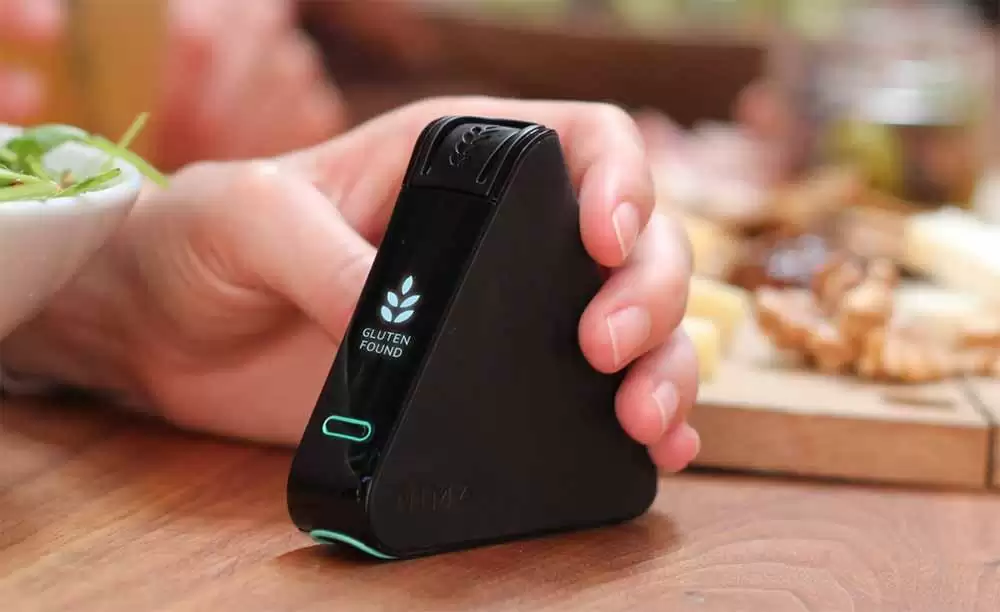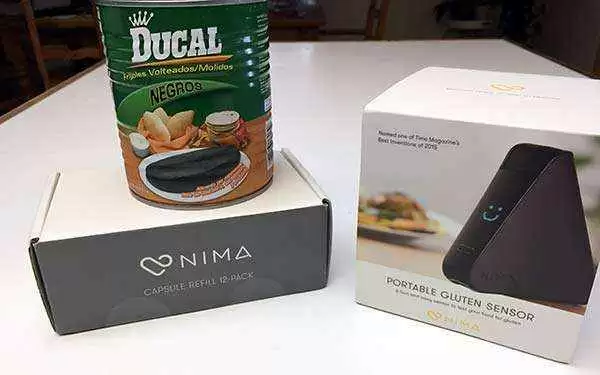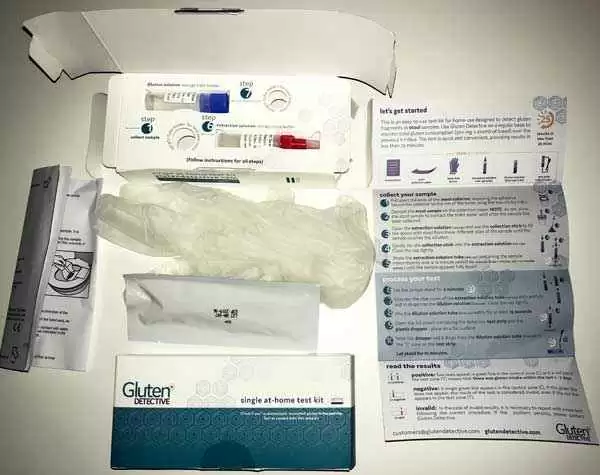
Celiac.com 09/14/2018 - Celiac.com was all set to do a story on the latest peer-reviewed data on the Nima gluten testing device, when along comes Gluten-Free Watchdog with another of their famous non-recommendations. Gluten-Free Watchdog says they cannot recommend the Nima gluten test kit because of alleged flaws.
But what does the science say? The latest Nima article and Gluten-Free Watchdog’s complaint both focus on the science, so let’s start there.
Celiac.com Sponsor (A12):
Nima makes two different food sensors: one detects gluten, the other detects peanuts. Each sensor comprises a small, handheld electronic device and a cartridge. To test food, consumers place a pea sized amount into the cartridge, place the cartridge inside the sensor, and run the device. They then receive a smiley face or wheat symbol with "gluten found," depending on whether or not the Nima device detected the allergen.
Nima reported their original data in a peer-reviewed scientific journal. Among the conclusions: “Compared with reference R5, Nima antibodies (13F6 and 14G11) had 35- and 6.6-fold higher gliadin affinities, respectively. Nima demonstrated device performance using a comprehensive list of foods, assessing detection sensitivity, reproducibility, and cross-reactivity. Nima presented a 99.0% true positive rate, with a 95% confidence interval of 97.8%–100%.”
Gluten Free Watchdog says that:
- “Based on third party testing data, the Nima Sensor fails to detect gluten at the 20 ppm level over 20 percent of the time. It isn’t until a sample contains a level of gluten at the 40 ppm level, that a gluten found result is received close to 100% of the time.”
Gluten Free Watchdog suggests that this is a problem, because:
- “At a level of gluten in a sample from less than 2 ppm up to a level of gluten between 30 ppm and 40 ppm, the result displayed on the Nima Sensor may be either smiley face or gluten found. If a sample is tested with a Nima Sensor and the result is a smiley face, there is no practical way for a consumer to know if the level of gluten in the sample is less than or more than 20 ppm. If a sample is tested with a Nima Sensor and the result is gluten found, there is no practical way for a consumer to know if the level of gluten in the sample is less than or more than 20 ppm. As a result, the data point received from the Nima Sensor for gluten presents major interpretation problems.”
Gluten Free Watchdog charges that Nima uses “NOT the scientifically validated Ridascreen Gliadin R5 ELISA Mendez Method from R-Biopharm used by Gluten Free Watchdog.” The fact is that R5 Elisa remains the industry standard for most testing applications.
Gluten Free Watchdog closes its warning with a word from their independent expert: According to Adrian Rogers, Senior Research Scientist at Romer Labs, “It could be argued that the device is not fit for purpose as the company states that there is a clear differentiation between safe and unsafe products based on a 20 ppm level which the validation data does not corroborate.”
It’s worth noting that for all his accomplishments, Rogers is neither a doctor, nor a PhD. Rogers' LinkdIn page lists his education as: Bsc (Hons), Microbiology, University of Wales, Aberystwyth. A Bachelor of Science degree may not necessarily make an expert in this subject, yet he is presented as one.
Rogers also seems to have a potential conflict of interest that was omitted in Thompson’s press release. Directly from Rogers’ LinkdIn site:
- “Romer Labs®, Inc. developed an immunochromatographic lateral flow assay for the qualitative detection of gluten in raw ingredients, processed foods, finished food products, and environmental surfaces, using the G12 antibody developed by Belén Morón. The G12 antibody targets a 33-mer peptide which is resistant to enzymatic digestion and heat denaturation, as well as being the fragment of the gliadin protein to which celiac disease sufferers react, making it a reliable analytical marker.”
The company Rogers works for, Romer Labs, makes its own gluten testing kits. It seems a bit disingenuous for Gluten Free Watchdog to use a spokesperson from a potentially competing company to try to counteract a peer-reviewed scientific publication for a device which is made by a potential competitor.
Nima’s Scientific Advisory Board includes some of the most highly respected celiac disease researchers and scientists in the world. They include: Peter HR Green, MD Phyllis and Ivan Seidenberg Professor of Medicine. Director, Celiac Disease Center at Columbia University; Jody Puglisi, PhD Stanford University Professor of Structural Biology; Lucille Beseler, MS, RDN, LDN, CDE, FAND Family Nutrition Center of South Florida; Benjamin Lebwohl, MD, MS Director of Clinical Research Celiac Disease Center at Columbia University; John Garber, MD Gastroenterology, Mass General; and Thanai Pongdee, MD Consultant, Division of Allergic Diseases, Mayo Clinic.
Nima says that Gluten Free Watchdog’s view of their recently published validation is incomplete and misleading. Nima wrote:
- “All the studies show Nima is highly sensitive across a range of both low and high levels of gluten."
- "The Nima third party data accurately reported gluten found at 20 ppm and above between 93.3% for food as prepared (a food item that is spiked with an intended quantity of gluten) and 97.2% for food as quantified by an ELISA lab kit (used to determine the exact ppm of gluten in the food)."
- "The Nima peer reviewed study published in the Food Chemistry Journal reported gluten found at 20 ppm and above at 96.9% accuracy."
The statement that:
- “'Nima will fail to detect gluten at 20 ppm 20% of the time' is almost entirely driven by 1 specific food out of 13 tested. That sample, when quantified, was actually below 20 ppm."
- "In real life, people get glutened at many different ppm levels, not just 20 ppm. Nima has been shown to detect gluten at levels below, at and above 20 ppm across a variety of foods in a number of studies.”
Reading the peer reviewed data provided by Nima, and reading Gluten Free Watchdog’s complaints, it becomes clear that Gluten Free Watchdog’s complaints sound serious and authoritative, but ring a bit hollow.
Consider the Following Analogy
Imagine a gluten-sniffing dog that performed as well as Nima in scientific trials; same performance, same exact data.
You can give this dog a sniff, or a small bite of food, and he can signal you if the food’s got gluten in it with 97% accuracy at 20ppm or below. Nearly 100% accuracy at 40ppm or above (as stated by Gluten Free Watchdog).
People would think that the dog was not only cute and fluffy, but wonderfully helpful and everyone would love it, and everyone with celiac disease would want one. And it would be a great big gushing warm and fuzzy feel-good story. Pretty much no one would be arguing that the dog was potentially dangerous, or somehow unfit for people with celiac disease. Such dogs would also be far more expensive to own and maintain than the Nima device. Apparently such dogs can cost upwards of $16,000, not including the cost of food, vet bills, etc.
So, what’s the accuracy rate of a gluten-sniffing dog, anyway? From Mercola.com: Willow, a German shorthaired pointer, is another gluten-sniffing dog, in this case living in Michigan. Her owner, Dawn Scheu, says she can detect gluten with 95 percent to 98 percent accuracy. She worked with a trainer (the same one who trained Zeus) to teach her own dog to detect gluten, with excellent results.
Gluten-sniffing dogs may detect gluten in amounts as small as .0025 parts per million with 95 percent to 98 percent accuracy. So, will Gluten Free Watchdog be warning against gluten-sniffing dogs anytime soon?
Somehow, because Nima is a mechanical device made by a company, it's not so warm and fuzzy, not so feel-good. Maybe Nima needs to shape their device like a cute little doggy, or a Pez candy dispenser?
But the data remains, as does the fact, whatever its drawbacks, anything that detects gluten like Nima does, as well as it does, is potentially very helpful for celiac disease in numerous situations. And it is extremely unlikely to do them any harm.
Nima seems very much committed to transparency, scientific excellence, and continual product improvement. These are noble goals and generally a win for people with celiac disease. Think of it, just ten years ago, a portable gluten-sensor with the kind of accuracy Nima is reliably achieving would have been the stuff of fantasy. Yet here it is. More accurate than any gluten-sniffing dog, and for a couple hundred bucks. People with celiac disease are living in a very different world than just a few years ago.
Nima did not have to publish its data, but it chose to do so, and in a reputable, peer-reviewed scientific journal. Nima conducted its research using solid scientific standards, and reported those results publicly. They explained their methodology and results, they acknowledged product limitations and expressed a commitment to improvement. How is this remotely controversial?
The celiac disease community is fortunate to have companies committed to investing time and money into products and devices that help to improve the lives of people with celiac disease. We feel strongly that the perfect should not be the enemy of the good. Devices like the Nima gluten sensor can be helpful for numerous people with celiac disease.
Disclosure: Nima is a paid advertiser on Celiac.com. Celiac.com's advertisers do not influence our editorial content.
- Read Nima’s full report on test data at: Food Chemistry.com
- Read Gluten Free Watchdog’s Statement on the Nima device at: Glutenfreewatchdog.org
- Read Nima’s Reply to Gluten Free Watchdog at: Nimasensor.com



.webp.f5a77a48246f9c753b586431f828abcf.webp)




Recommended Comments
Create an account or sign in to comment
You need to be a member in order to leave a comment
Create an account
Sign up for a new account in our community. It's easy!
Register a new accountSign in
Already have an account? Sign in here.
Sign In Now